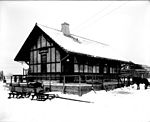Arden (estate)
Carrère and Hastings buildingsChâteauesque architecture in the United StatesColumbia University campusGilded Age mansionsHarriman family ... and 7 more
Houses completed in 1909Houses in Orange County, New YorkHouses on the National Register of Historic Places in New York (state)National Historic Landmarks in New York (state)National Register of Historic Places in Orange County, New YorkRamaposUse mdy dates from August 2023

Arden is a historic estate outside Harriman, New York, that was owned by railroad magnate Edward Henry Harriman and his wife, Mary Averell Harriman. By the early 1900s, the family owned 40,000 acres (63 sq mi; 160 km2) in the area, half of it comprising the Arden Estate. The main house is at the top of a mountain east of the village, reachable by Arden House Road from NY 17. Since 2011, it has been owned by the nonprofit Research Center on Natural Conservation, which operates Arden House as a conference center with 97 guest rooms.
Excerpt from the Wikipedia article Arden (estate) (License: CC BY-SA 3.0, Authors, Images).Arden (estate)
Arden House Road,
Geographical coordinates (GPS) Address External links Nearby Places Show on map
Geographical coordinates (GPS)
| Latitude | Longitude |
|---|---|
| N 41.296666666667 ° | E -74.119166666667 ° |
Address
Arden House
Arden House Road 293
10928
New York, United States
Open on Google Maps






